Asemic writing
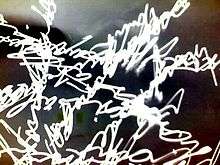
Asemic writing is a wordless open semantic form of writing.[1][2] The word asemic means "having no specific semantic content".[3] With the non-specificity of asemic writing there comes a vacuum of meaning which is left for the reader to fill in and interpret. All of this is similar to the way one would deduce meaning from an abstract work of art. Where asemic writing differs from abstract art is in the asemic author's use of gestural constraint, and the retention of physical characteristics of writing such as lines and symbols. Asemic writing is a hybrid art form that fuses text and image into a unity, and then sets it free to arbitrary subjective interpretations. It may be compared to free writing, or writing for its own sake, instead of writing to produce verbal context. The open nature of asemic works allows for meaning to occur across linguistic understanding; an asemic text may be "read" in a similar fashion regardless of the reader's natural language.[4] Multiple meanings for the same symbolism are another possibility for an asemic work.
In 1997 visual poets Tim Gaze and Jim Leftwich first applied the word asemic to name their quasi-calligraphic writing gestures. They then began to distribute them to poetry magazines both online and in print. The authors explored sub-verbal and sub-letteral forms of writing, and textual asemia as a creative option and as an intentional practice. Since the late 1990s, asemic writing has blossomed into a worldwide literary/art movement. It has especially grown in the early part of the 21st century, though there is an acknowledgement of a long and complex history which precedes the activities of the current asemic movement, especially with regards to abstract calligraphy, wordless writing, and verbal writing damaged beyond the point of legibility. Jim Leftwich has recently stated that an asemic condition of an asemic work is an impossible goal, and that it is not possible to create an art/literary work entirely without meaning. He has begun to use the term 'pansemic' to describe this type of work.[5]
Styles of asemic writing
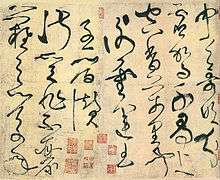
Some asemic writing includes pictograms or ideograms, the meanings of which are sometimes, but not always, suggested by their shapes. Asemic writing, at times, exists as a conception or shadow of conventional writing practices. Reflecting writing, but not completely existing as a traditional writing system, asemic writing seeks to make the reader hover in a state between reading and looking.[6]
Asemic writing has no verbal sense, though it may have clear textual sense.[7] Through its formatting and structure, asemic writing may suggest a type of document and, thereby, suggest a meaning. The form of art is still writing, often calligraphic in form, and either depends on a reader's sense and knowledge of writing systems for it to make sense, or can be understood through aesthetic intuition.[8]
True asemic writing occurs when the creator of the asemic piece cannot read their own asemic writing. Relative asemic writing is a natural writing system that can be read by some people but not by everyone (e.g. ciphers). Between these two axioms is where asemic writing exists and plays.[9]
Influences on asemic writing are illegible, invented, or primal scripts (cave paintings, doodles, children's drawings, etc.). But instead of being thought of as mimicry of preliterate expression, asemic writing may be considered to be a global postliterate style of writing that uses all forms of creativity for inspiration. Other influences on asemic writing are xenolinguistics, artistic languages, sigils (magic), undeciphered scripts, and graffiti.[10]
History
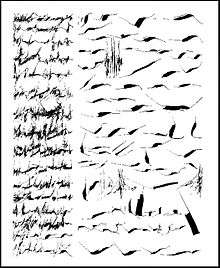
Asemic writing occurs in avant-garde literature and art with strong roots in the earliest forms of writing. The history of today's asemic movement stems from two Chinese calligraphers: "crazy" Zhang Xu, a Tang Dynasty (circa 800 CE) calligrapher who was famous for creating wild illegible calligraphy, and the younger "drunk" monk Huaisu who also excelled at illegible cursive calligraphy.[12] In the 1920s Henri Michaux, who was influenced by Asian calligraphy and Surrealism, began to create wordless works such as Alphabet (1925) and Narration (1927).[13] Michaux referred to his calligraphic works as "interior Gestures." The writer and artist Wassily Kandinsky was an early precursor to asemic writing, with his linear piece Indian Story (1931) exemplifying complete textual abstraction. In the 1950s there is Brion Gysin, Isidore Isou, Cy Twombly, and Morita Shiryu/Bokujin-Kai Group all of whom expanded writing into illegible and wordless visual mark-making; they would help lay the foundation for asemic writers of the future. Mirtha Dermisache is another writer who had created asemic writing since the 1960s.[14] Dermisache actively said that even though her graphisms have no meaning, they still retained the full rights of an autonomous work. 1971 was the year when Alain Satié released his work Écrit en prose ou L'Œuvre hypergraphique which contains asemic writing throughout the entire graphic novel.[15] León Ferrari was another artist/poet who created many asemic works in the 1960s and 70s, such as Escritura (1976).[16] A modern example of asemic writing is Luigi Serafini's Codex Seraphinianus. Serafini described the script of the Codex as asemic in a talk at the Oxford University Society of Bibliophiles held on May 8, 2009.[17] Roland Barthes was also involved with asemic writing; he titled his asemic works Contre-écritures.[18][19] 1974 saw the release of Max Ernst's work Maximiliana: The Illegal Practice Of Astronomy: hommage à Dorothea Tanning; this book is a major influence on asemic writers such as Tim Gaze, Michael Jacobson, and Derek Beaulieu.[20] In the 1980s Chinese artist Xu Bing created Tiānshū, or A Book from the Sky which is a work of books and hanging scrolls on which were printed 4000 hand carved meaningless characters.[21] The 1980s also saw artist Gu Wenda begin the first of a series of projects centered on the invention of meaningless, false Chinese ideograms, depicted as if they were truly old and traditional. One exhibition of this type was held in Xi'an in 1986, featuring paintings of fake ideograms on a massive scale.[22] Also in China, during the 1990s, an abstract calligraphy movement known as "Calligraphy-ism" came into existence, a leading proponent of this movement being Luo Qi. Calligraphy-ism is an aesthetic movement that aims to develop calligraphy into an abstract art. The characters do not need to retain their traditional forms or be legible as words. In Vietnam during the 2000s a calligraphy group called the Zenei Gang of Five appeared. To this group of young artists, “Wordless” means that which cannot be said, that which is both before and beyond the specificity of naming. To be without words is saying nothing and saying everything.
Specialized publications

2013 saw the release of An Anthology of Asemic Handwriting (Uitgeverij), which has over a hundred artists represented from many corners of the world.[23] Asemic writing has also received mention and space in The Last Vispo Anthology: Visual Poetry 1998-2008 (Fantagraphics, 2012). In 2011 a full issue of William Allegrezza's poetry journal Moria was focused on the participants and theory of asemic writing.[24] Also in 2011, John Moore Williams published an asemic issue of his journal The Bleed. Other publications that cover asemic writing include Tim Gaze's Asemic Magazine, Michael Jacobson's weblog gallery The New Post-Literate, and Marco Giovenale's curated group blog Asemic Net. Asemic writing has appeared in books, artworks, films and on television but it has especially been distributed via the internet (such as on Facebook, Tumblr, Pinterest, Youtube, Scribd, and Reddit). Group exhibits of asemic writing have occurred in Australia,[25] Russia,[26] Malta,[27] and Mexico.[28] More recently there have been architecture models which utilize asemic writing in the design process.[29][30] Currently, there is a robot that performs asemic writing live,[31] and there is asemic writing produced by artificial intelligence.[32]
Satu Kaikkonen, a contemporary asemic artist/writer, had this to say about asemic writing:
As a creator of asemics, I consider myself an explorer and a global storyteller. Asemic art, after all, represents a kind of language that's universal and lodged deep within our unconscious minds. Regardless of language identity, each human's initial attempts to create written language look very similar and, often, quite asemic. In this way, asemic art can serve as a sort of common language -- albeit an abstract, post-literate one -- that we can use to understand one another regardless of background or nationality. For all its limping-functionality, semantic language all too often divides and asymmetrically empowers while asemic texts can't help but put people of all literacy-levels and identities on equal footing.[33]
Bruce Sterling comments about asemic writing on his Wired magazine blog Beyond the Beyond:
Writing that doesn’t have any actual writing in it whatsoever. You would think that this must be some kind of ultimate literary frontier, a frozen Antarctica of writing entirely devoid of literary content, but I wonder.What is “beyond asemic writing”? Maybe a neural brain-scan of an author *thinking about* asemic writing. Maybe *generative asemic writing.* Maybe “asemic biomimicry.” Maybe nanoasemic writing inscribed with atomic force microscopes by Artificial Intelligences.[34]
False writing systems
False writing systems are artificially constructed alphabets or scripts used (sometimes within the context of a false document) to convey a degree of concealed verisimilitude. Examples of this include alien dialogue in comic strips, cartoons, and graphic novels (such as Alan Moore's The League of Extraordinary Gentlemen, and the Valérian and Laureline series). The script in Luigi Serafini's 1981 Codex Seraphinianus was confirmed by the author to have no occult meaning. The Voynich manuscript, a mysterious work in which the Codex Seraphinianus was likely based, uses an undeciphered writing system that some speculated to be false.
Influences, predecessors, & related forms


- From the Tim Gaze interview at The Commonline Journal: "you could say that nature, since time began, has been manifesting asemic writing. It just needs a human to see the writing, & recognize it."[35]
- Apophenia
- Artist's book
- Marian Bijlenga, Written Weed, a book of twigs and seeds laid out like text.
- Irma Blank [36]
- Jean Degottex
- Christian Dotremont, logograms.
- Timothy Ely; "Ely's work evokes a range of thematic material: arcane knowledge, secrets and cryptography, time and timelessness. He has developed a private written language using 366 individual signs or "idiographic cyphers."
- Glossolalia
- Rachid Koraïchi
- Wosene Worke Kosrof
- Ungno Lee, letter abstracts.
- Lettrisme, the letteristes often invented new symbols for their artworks and writing.
- Mumble Rap
- John Bunion Murray (JB Murray), personal spirit writing.
- Nonsense
- José Parlá, abstract graffiti.
- Prince (musician) name change.
- Retna, AKA Marquis Lewis, is a graffiti artist who has invented his own script.
- Scat singing
- Hélène Smith's conlang Martian.
- Sound poetry
- Austin Osman Spare, sigils.
- Un Coup de Dés Jamais N'Abolira Le Hasard (Broodthaers)
- Fabienne Verdier
- Visual poetry
- The Voynich manuscript, possibly a proto-asemic text.
- Made Wianta, calligraphy period.
- Wildstyle
- Ulfert Wilke and Abstract Expressionism.
Gallery
-

Math Minus Math: a text of asemic math by Rosaire Appel
-

Asemic translation of Flatland by Derek Beaulieu
-
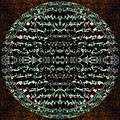
Asemic writing from Jean-Christophe Giacottino
-

Asemic hieroglyphs by Michael Jacobson for Rain Taxi's winter 2014 issue
-
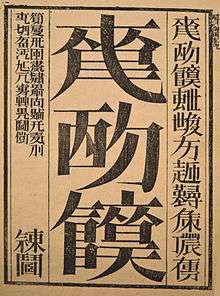
Title page of A Book from the Sky, in pseudo-Chinese characters. The characters “天書” (Tiānshū) do not appear anywhere in the book.
-

Kabbalistic painting representing the letters of the Hebrew alphabet in their mystical assignation as the building blocks of the physical universe in creation.
-

"Fusion Series #2174" By Cecil Touchon. A collage using fragments of lettering from found bill board material.
See also
- False writing system
- Graphology
- History of writing
- Lorem ipsum
- Lyrical abstraction
- Nonverbal communication
- Rorschach test
- Seme (semantics)
- Universal language
- Variable (mathematics)
Notes

- ↑ "TwentyFourHoursOnline". TwentyFourHoursOnline.
- ↑ "Tim Gaze. Asemic Magazine". Asemic Magazine.
- ↑ From Greek: asemos (αόεμoβ)= without sign, unmarked, obscure, or ignoble.
- ↑ "SCRIPTjr.nl". SCRIPTjr.nl.
- ↑ "Jim Leftwich: "asemic writing definitions and contexts, 1998-2016"".
- ↑ Jaime Morrison. "Nonism: Asemic Art".
- ↑ Geof Huth. "Varieties of Visual Poetry". dbqp.
- ↑ Michael Jacobson. "Works & Interviews 1999-2014".
- ↑ "PRATE". Fullofcrow.com. Retrieved 10 November 2014.
- ↑ "SCRIPTjr.nl". SCRIPTjr.nl. Retrieved 10 November 2014.
- ↑ dermisache-9 Newsletters & 1 Reportaje 2000: Newsletter, 2000 from Mirtha Dermisache, Nueve Newsletters & Un Reportaje, Buenos Aires : El borde, Marseille : Mobil-Home, Montpellier : Manglar, 2004. Offset printing, 440 copies.
- ↑ Sarah Nicholls. "Center for Book Arts: Making Sense of Asemic Writing". Centerforbookarts.blogspot.com. Retrieved 10 November 2014.
- ↑ "'Leaking the Squalls': The Art and Letters of Henri Michaux". natalie ferris. Retrieved 10 November 2014.
- ↑ "Witness Mirtha Dermisache". Jacket2.org. Retrieved 10 November 2014.
- ↑ Alain Satie, Écrit en Prose, Éditions PSI, 1971.
- ↑ Buzz Poole. "The Writing of Art, The Art of Writing". Printmag.com.
- ↑ Jeff Stanley (2010). "To Read Images Not Words: Computer-Aided Analysis of the Handwriting in the Codex Seraphinianus (MSc dissertation)" (PDF). North Carolina State University at Raleigh. pp. 8–9. Retrieved 9 April 2012.
- ↑ Tierra Innovation. "Vispo". Theparisreview.org. Retrieved 10 November 2014.
- ↑ "Drawings on Writing". Drawingsonwriting.org. Retrieved 10 November 2014.
- ↑ "PRATE". Fullofcrow.com. Retrieved 10 November 2014.
- ↑ "Free writing". stalker. Retrieved 10 November 2014.
- ↑ "asemic writing - Donna Tull". Lacon4.wordpress.com. Retrieved 10 November 2014.
- ↑ "Nick Pelling, Cipher Mysteries Blog: Review of "An Anthology of Asemic Writing"…2013/09/22". Archived from the original on September 14, 2014.
- ↑ "moria". Moriapoetry.com. Retrieved 10 November 2014.
- ↑ "Asemic writing at The Hahndorf Academy".
- ↑ "The First Asemic Writing Exhibit In Russia".
- ↑ "Asemic Show at the Spiral, Malta".
- ↑ "First Asemic Writing Exhibit In Mexico".
- ↑ "Asemic Scapes by Sarah Schneider". Dezeen. Retrieved 10 November 2014.
- ↑ "suckerPUNCH » Asemic ForestsuckerPUNCH". SUCKERPUNCHDAILY.COM. Retrieved 10 November 2014.
- ↑ "The Post-Literate (R)Evolution". Post-literate.tumblr.com. Retrieved 10 November 2014.
- ↑ "Asemic AI".
- ↑ "SCRIPTjr.nl". SCRIPTjr.nl. Retrieved 10 November 2014.
- ↑ Sterling, Bruce (July 13, 2009). "Web Semantics: Asemic writing". Wired.com. Retrieved February 29, 2016.
- ↑ "The Commonline Journal: Without Words: An Interview with Tim Gaze". Commonlinejournal.com. Retrieved 10 November 2014.
- ↑ "Gammm: le scritture asemantiche di irma blank / gillo dorfles. 1974". Marco Giovenale with English translation by Nerida Newbigin, 2014.
- ↑ "asemic-writing-matox". Post Graffiti :: Urban Skins. Retrieved 10 November 2014.
References

- Derek Beaulieu, Flatland. York: Information as Material, 2007 ISBN 978-0-9553092-5-0
- John Cayley (Author), Lydia Liu (Author), Katherine Spears (Editor), Xu Bing (Artist), Xu Bing: Tianshu: Passages in the Making of a Book. Bernard Quaritch Ltd.; Bilingual edition, 2012. ISBN 978-0955085291
- Max Ernst, Maximiliana: The illegal practice of astronomy : hommage à Dorothea Tanning. New York Graphic Society,1974. ISBN 978-0821206553
- Tim Gaze, The Oxygen Of Truth, Vol. 1 & 2. Broken Boulder, 1999- 2000.
- Tim Gaze, Jim Leftwich, Louise Tournay, Abdourahamane Diarra, Joe Maneri, ASEMIA. Anabasis/Xtant, 2003. ISBN 1930259344
- Tim Gaze, Writing. xPress(ed), 2004. ISBN 951-9198-86-5
- Tim Gaze, Noology. Arrum Press, 2008.
- Tim Gaze, 100 Scenes. Transgressor Press, 2010. ISBN 978-0-9807303-4-0
- Tim Gaze & Michael Jacobson (editors), An Anthology Of Asemic Handwriting. Uitgeverij, 2013. ISBN 978-9081709170
- Marco Giovenale, Asemic Sibyls. Red Fox Press, 2013.
- Michael Jacobson, The Giant's Fence. Ubu Editions, 2001-2006.
- Carlos Martínez Luis, Nomadic and Archeological Scriptures. LUNA BISONTE PRODS, 2009.
- Luna-Park 2, 1976.
- Raymond Queneau, Ecritures. Secret Books, 2015.
- Alain Satié, Written in Prose. Asemic Editions, 2011.
- Luigi Serafini, Codex Seraphinianus. Milano: Rizzoli, 2013, 396 pp., ISBN 08-47-84213-4
- Paul A. Toth (editor), ALPHA BET A TEST: The Eye Am Eye Asemic Anthology: Language in the Act of Disappearing. Eye Am Eye Press, 2015. ISBN 978-1511706056
- Zoomoozophone Review 8, 2016.
External links
- Lemonhound interview with Kerri Pullo
- Full of Crow interview with Tim Gaze
- Samplekanon interview with Michael Jacobson
- Asymptote Journal interview with Michael Jacobson
- David Alan Binder interview with Michael Jacobson
- 3:AM Magazine interview with Marco Giovenale
- NY Times: When How It Looks Matters More Than What It Says by Ken Johnson
- Bright Stupid Confetti: Asemic Writing: An International Perspective
- Institute Of Network Cultures: Asemia and the Gesture of Writing by Matt Beros
- Design Observer: Asemic Writing: Open to Interpretation by John Foster
- Asemic Writing & Project: Ekaterina Samigulina & Karen Karnak
- Utsanga: Aprile-Caggiula: About Asemic Writing
- Asemic Writing: Backwards Into The Future by Peter Schwenger
- Artforum: Creative Writing: Travis Jeppesen on Wang Dongling
- Real Life Magazine: Definition Not Found by Rahel Aima